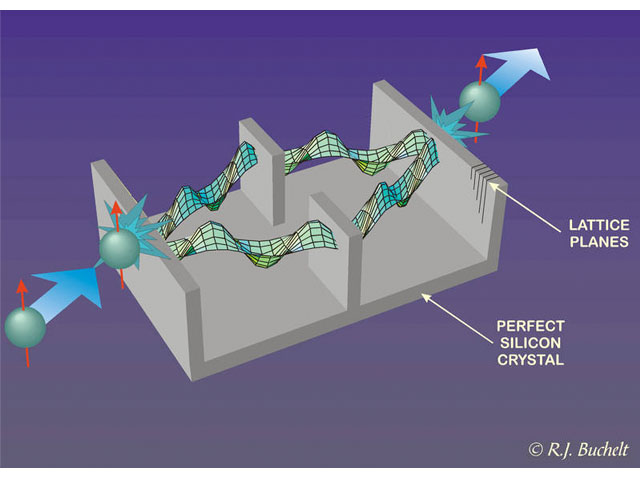S18
CRG-B - Thermal neutron interferometer
How interferometry works
Perfect crystal interferometer
The Mach-Zehnder type interferometer consists of perfect crystal slabs which act as beam splitter for thermal neutrons. The [220] lattice planes of silicon crystals are used in symmetric Laue geometry, i.e. the lattice planes are prependicular to the crystal surface. Part of the beam is reflected by Bragg diffraction while the rest is transmitted in forward direction. Three of such crystals constitute the interferometer which is therefore also called triple Laue or LLL interferometer. The first crystal (beam splitter) splits the neutron beam coherently into two parts. The beams are redirected towards each other by the second crystal (mirror) and recombined by the third crystal (analyzer).
Phase measurement
A phase shifter, e.g. an aluminium slab, intersects both beam paths in the interferometer. If the phase shifter is rotated, the optical path length is changed differently in each beam path, and the phase between the two paths can be controlled. Two exit beams emerge from the last crystal slab. They are denoted by "O" beam (forward direction) and "H" beam (Bragg diffracted direction). As the phase shifter rotates, the intensity oscillates between the two exit beams. If a sample is inserted in one beam path, the intensity oscillation shifts, revealing directly the phase shift due to the sample. If thickness and density of the sample are known, one can calculate the neutron scattering length of the sample material.
Quantum world
Neutron interferometry is based on single particle interference. Considering the flux and the flight times, there are hardly ever two neutrons simultaneously present in the interferometer. (Being fermions, they wouldn't be in the same state anyway.) Every single neutron becomes a superposition of "taking the left path" and "taking the right path" and finally interferes with itself. Therefore, neutron interferometry is a perfect tool to study the neutron as a quantum object.
The two beam paths can be understood as a two level quantum system. Another two level quantum system is the neutron spin. The spin can be manipulated with or without energy transfer by applying static or oscillating magnetic fields respectively. Thus the neutron energy can be accessed as a third degree of freedom. With these methods, quantum phenomena have been studied over many decades, e.g. the 4 pi symmetry of spin-half particles in 1975, or the Cheshire Cat states in 2014.
Stability
The crystal slabs of the interferometer have to be kept extremely stable in respect to each other. If one of the crystals is transversally displaced by one lattice constant (2Å) a phase shift of 360° is introduced. Consequently, a sub-picometer stability is required over the passage time of the neutron (100µs) if phase shifts in the order of 1° are to be resolved. This stability is obtained by the monolythic design of the interferometer. All crystal slabs are cut from the same crystal ingot and are still connected by a common crystal base. The interferometer size is therefore limited by the size of available perfect crystal ingots. In addition, the interferometer crystal has to be mounted without stress, external vibrations have to be suppressed and the surrounding temperature must be stable and homogenious.
How USANS works
The USANS setup, also called Bonse Hart camera, consists of two perfect Bragg crystals in non-dispersive configuration. If the lattice planes of both crystals are aligned exactly parallel to each other, all neutrons reflected by the first crystal are also reflected by the second crystal, regardless of the beam divergence. If the second crystal is slightly rotated, the reflected intensity drops to zero very fast, thanks to the narrow Bragg reflection curve of perfect crystals. The convolution of two such curves yields the USANS rocking curve which shows a triangular peak with FWHM=1.3 arcseconds. Triple-bounce "channel cut" crystals are used for both monochromator and analyzer crystal in order to suppress the tails of the peak.
Samples are placed in front of the second crystal. Horizontal scattering is directly recorded by the rocking curve while vertical scattering is not visible. The angular resolution does not depend on the beam divergence nor on the beam diameter nor on the sample size. The scattering signal is averaged over the whole sample volume. The data can be postprocessed by "desmearing" routines in order to make it comparable to the two-dimensional scattering data from a SANS instrument.

